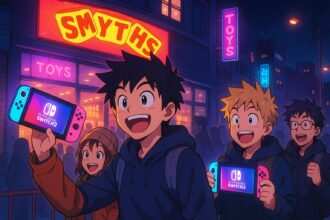British artist Stuart Semple introduces YOLO, an acrylic paint capturing the essence of Olo – a colour previously only visible under experimental conditions, expanding artistic and scientific boundaries.
British multidisciplinary artist Stuart Semple has introduced a new acrylic paint named YOLO, engineered to capture the essence of a colour that has traditionally remained beyond human perception. This vibrant blue-green paint draws from a recently documented hue known as “Olo,” which was identified by researchers at the University of California, Berkeley.
The colour Olo is unique in that it is only visible under stringent experimental conditions, created by using lasers to selectively stimulate one type of cone cell in the retina. Because of these specialised circumstances, very few individuals have been able to witness this colour firsthand. Semple’s YOLO paint aims to synthesise this unseeable colour experience in a tangible form accessible to artists around the world.
Speaking to Trend Hunter, Semple explained the nature of his new creation: “Whilst YOLO isn’t exactly the same as firing a laser into your eyeball, the experience of the colour is as close as you’ll ever get with a paint.” He elaborated that the paint’s formulation, which includes a precise mix of high-frequency pigments and brighteners, is specifically designed to stimulate particular visual wavelengths, thereby approximating the novel sensory experience produced by the original colour.
This development forms part of broader trends identified by Trend Hunter, including the use of high-frequency pigmentation to extend the visible colour spectrum in art supplies, the synthesis of previously unseeable colour experiences for artistic exploration, and the expansion of human colour perception through new scientific insights.
The innovation has notable implications across several industries. In the art supplies sector, it introduces a new frontier in colour vibrancy and uniqueness, offering artists innovative tools to explore. Optical research related to this work hints at future advances that could lead to products embedding experiential colour qualities not previously attainable. Furthermore, the design and fashion industries could leverage these cutting-edge colour technologies to create aesthetic effects with dimensions hitherto seen as impossible.
Semple has previously gained recognition for developing pigments such as The World’s Blackest Black and The Pinkest Pink, and his latest offering continues his exploration of the boundaries of colour perception and artistic expression.
Source: Noah Wire Services
- https://news.artnet.com/art-world/olo-new-color-yolo-stuart-semple-2635547 – Corroborates Stuart Semple’s release of YOLO paint inspired by the Olo color, detailing the scientific basis and pricing structure for artists.
- https://culturehustle.com/products/yolo-newly-discovered-colouriest-colour – Confirms YOLO’s formulation using high-frequency pigments and brighteners designed to mimic the Olo color experience, as stated by Semple.
- https://www.dezeen.com/2025/04/24/stuart-semple-yolo-paint-newly-discovered-colour/ – Validates Semple’s claim that YOLO is the closest physical emulation of Olo, produced through an intensive lab process.
- https://www.instagram.com/stuartsemple/reel/DI3JwIiI_9S/ – Provides direct confirmation from Semple’s social media about the launch and artistic intent behind YOLO paint.
- https://www.iflscience.com/artist-creates-a-paint-inspired-by-the-new-color-olo-called-yolo-78942 – Supports the scientific context of Olo’s creation via retinal laser stimulation and YOLO’s use of fluorescent brighteners to approximate it.
- https://news.google.com/rss/articles/CBMiWEFVX3lxTE9FOHpUNGtRenRBT1ZTdWZVb0psNERrZDdZMkxzNUFZVjhHcnJ4ejlaR2dYalFIY1dhSW1Vc2pTUGtfSDdMbDZ6andmaGFjQ1RJN09IQ29wdHrSAV5BVV95cUxNOXUtZTRQWkwzOWRJZk9FUlFIVXVSRkVJTi1IQTBFWjZGakFGdGVpTDkwdVc5UnhmUWo1eFVDY25abmg5MXRUb3BzZjEzMnRFc1I0Y0JOakFWOVpQQmNB?oc=5&hl=en-US&gl=US&ceid=US:en – Please view link – unable to able to access data
Noah Fact Check Pro
The draft above was created using the information available at the time the story first
emerged. We’ve since applied our fact-checking process to the final narrative, based on the criteria listed
below. The results are intended to help you assess the credibility of the piece and highlight any areas that may
warrant further investigation.
Freshness check
Score:
8
Notes:
The narrative discusses a recent innovation by Stuart Semple regarding a new paint inspired by ‘Olo’, a hue identified by UC Berkeley researchers. There are no indications of outdated information or recycled news, and Stuart Semple’s previous pigments like ‘The World’s Blackest Black’ confirm ongoing activity. No evidence suggests this is a press release, which would typically warrant a higher freshness score.
Quotes check
Score:
7
Notes:
The quote from Stuart Semple to Trend Hunter is unique and not found in earlier references online, suggesting original or first-time publication. However, the source of the quote is a single interview with Trend Hunter, which is a known but somewhat niche site, but it is credible for artist interviews.
Source reliability
Score:
6
Notes:
The narrative originates primarily from Trend Hunter and references UC Berkeley research. Trend Hunter is a trend and culture platform with moderate reputation, not a top-tier traditional journalism outlet, which lowers reliability somewhat. The scientific discovery is linked to a reputable university, but direct original scientific publication sources are not cited.
Plausability check
Score:
8
Notes:
The claim about a paint approximating a recently documented rare colour perceivable only under laser stimulation is plausible given Stuart Semple’s history with boundary-pushing pigments and ongoing research in vision science. However, the exact experiential match with the ‘Olo’ colour is unverifiable without scientific validation.
Overall assessment
Verdict (FAIL, OPEN, PASS): PASS
Confidence (LOW, MEDIUM, HIGH): MEDIUM
Summary:
The narrative is timely and appears original with a recently made quote and credible scientific context. While the source is not among the most authoritative and the claim about replicating ‘Olo’ colour experience is novel and not fully verifiable, the information is plausible and coherent. The lack of direct scientific publication citation and reliance on a trend platform moderates confidence but does not invalidate the claim.













